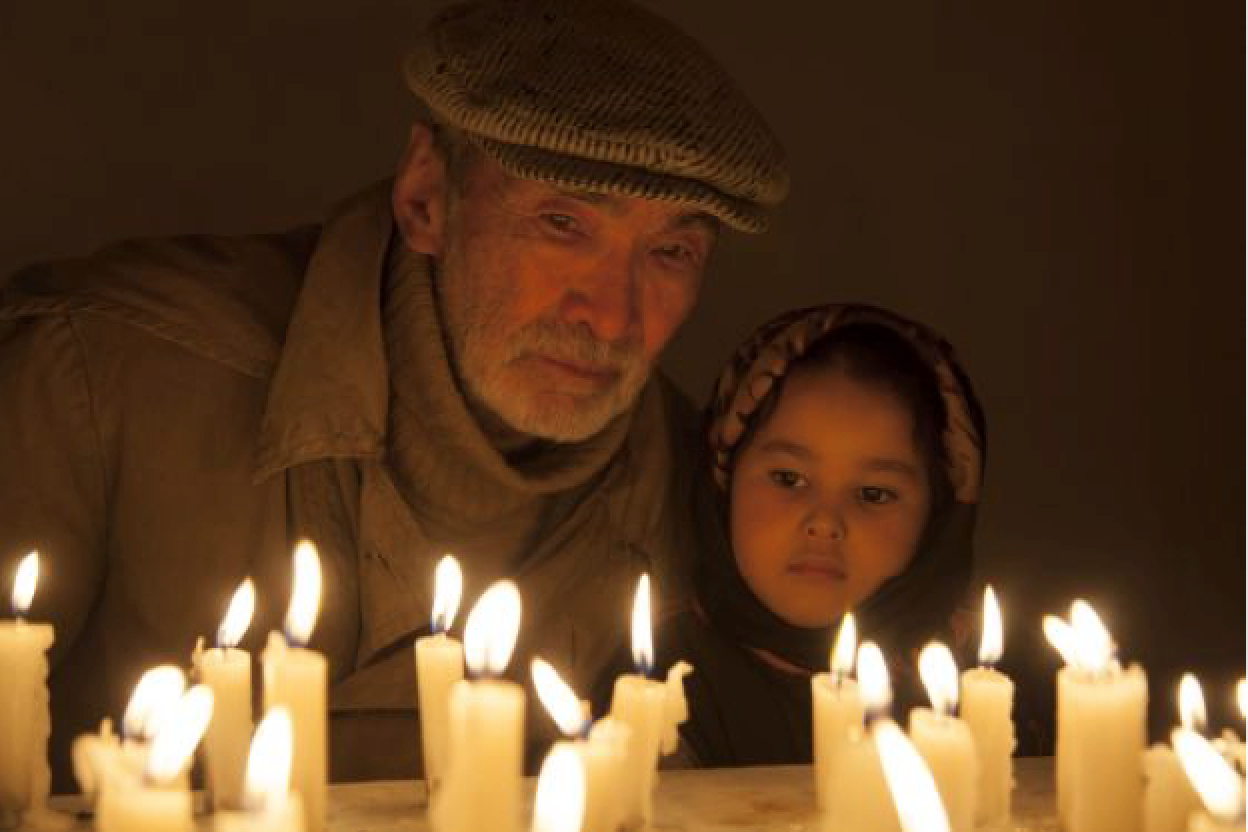The Move

June 05, 2020 - June 12, 2020
In a small house on the riverbank, an old man lives with his granddaughter. Not suspecting that all the savings have burned out, and the bank will requisition the apartment for non-payment of interest, his daughter asks the old man to sell the house and move into Bishkek with her. The family is forced to live in a wretched trailer at a railway dead-end ...
The Route of Homeless
Marat Sarulu has never been a diligent chronicler, a devotee of deliberate hyperrealism. He made the metaphorical cinema, where the game of authenticity was only one of the director’s tricks among other conventions. A specific default system worked. The logic of human relations was preserved (it was the author who first of all cared for this), but naturalism was noted in detail and with his motivation. Reductions were subjected to excesses in idle everyday details as insignificant signs of fleeting time.
Essay
Sergey Anashkin, old.kinoart.ru
The film lasts for almost three hours. Its rhythm is leisurely, like a trickling stream of water. Running water is one of the visual refrains of the picture. It is an ambiguous image: both a symbol of translational motion and a sign of limitedness. The meeting of land and water marks the boundary of possibilities, there is no further pedestrian. Go with the flow. In the abyss - from everyday problems, from asphyxiating hopelessness - suicides seek for rescue.
The story told in the picture resembles typical plots of neorealist dramas. A woman calls an elderly father and a young daughter into the city. They do not yet know that all the savings have been burnt, and the bank requisitioned the apartment for the non-payment of interest. The house in the village was sold. The family huddles in a wretched makeshift accommodation, in a trailer at a railway’s dead end. The mother and her daughter go around the district, visiting the homes of relatives (close and distant) and neighbors.
None of them accepts to shelter a child even for a short time. They themselves can barely make ends meet. The outcome of the ordeal is far from a benign happy ending: the baby goes to an orphanage, the grandfather goes to a nursing home, the woman is forced to leave to work in Russia. An ordinary, even story. It has an unusual tone, and a non-standard way of presenting the material.
The heroes of the picture are typical characters, standing in as units of human rights’ reports. Woman, old man, and child. Milestones of movements in the plot are also not accidental: the native shack - a temporary shelter - a roof over your head. Significant objects. There is a meditative rhythm, a leisurely narrative that hides effects but does not undo the tragedy of the inner situation that is in fact ordinary. Losing a home, and breaking with a usual way of life is always a disaster.
A few years ago, Marat Sarulu gave me an album of selected photographs taken by Shailo Dzhekshenbaev (“Experience of Silence”, Bishkek, 2006), where landscape photographs prevailed in the compilation. He himself published this book; he himself wrote the introductory essay to it. In the asceticism of self-sufficient landscapes, the director found “meaningless meaning…[that]…dissolves in the static atmosphere of the frame, absorbing it with the general mood”, giving rise to a special “chronotope of silence” when “time passes into space”. He was fascinated by "barely noticeable, elusive transitions" of natural conditions. The urban environment in such a coordinated system is "fundamentally anonymous and unrecognizable." In order to "enter into a single resonance with the secret spirit of the place," you need a "sensitive perception and silence of the mind." You read and you are surprised by how the interpretation of other people's works clearly appears in the director’s intended images to the film that has not yet been shot.
Marat Sarulu has never been a diligent chronicler, a devotee of deliberate hyperrealism. He made metaphorical cinema, where the game of authenticity was only one of the director’s tricks among other conventions. A specific default system worked. The logic of human relations was preserved (it was the author who first of all cared for this), but naturalism was noted in detail and with his motivation. Reductions were subjected to excesses in idle everyday details as insignificant signs of fleeting time.
In “The Move”, its style drifts from formal realism to pure abstraction. The director and director of photography (Boris Troshev, one of the leading representatives of new Kazakh cinema) sought to achieve ultimate generalization. The picture is made so that the houses - both rural shacks and urban high-rise buildings - look like a minimalist construction, the embodiment of elementary forms. Living spaces are neutral, free from stains of decoration (which would distract the eye). They are reduced to visual, cubistic volumes. Architecture becomes deconstructed as geometry.
Cold tones are dominant. Close-ups are rare. The predominance of medium and general plans separates the characters from the observer. We see figures from afar and from the side. Shooting is often done through the doorway or through the square of a window: personal space is strictly outlined, the figure is inscribed in the frame, the subject is “quoted”, enclosed in a picture frame, and is not as much a hero as an object of contemplation in the formal axis of the composition of the frame.
Signs of Asian exoticism are deliberately leveled; ethnic surroundings are erased. Yurts appear in the picture only once: the train, in which grandfather and granddaughter ride, sweeps past a string of identical hemispheres. The director chooses anthropogenic landscapes: the surroundings of a hydroelectric station, a railway dead-end, city backyards, through a wasteland, where plastic bags cling to grass stems. Both nature and architectural interiors exude metaphysical coolness (as on the textbook canvases of Giorgio de Chirico). The rooms are not inhabited; the landscapes are deserted. Most likely, the shooting was carried out in the very early morning hours. The environment is depersonalized, and indifferent to human beings.
Against these conditions of the background, the living features of the main characters of the picture are clearly visible. The household environment is outlined sparingly. But the grouping together of the urgent problems of modern Kyrgyzstan is not difficult to reconstruct - one only has to delve into the subordination of actions and recognize the social conditioning of the scenarios.
Khibara, where the grandfather and granddaughter lived, was sold for mere pennies. There is no decent work at the decaying hydroelectric station in the village. People of working age are struggling with a lack of money. Some leave their homes, seeking their fortune in big cities. Others treat depression with alcohol.
The old man’s daughter works as a dishwasher in Bishkek (in the frame again, water is an annoying dripping from the tap). Divorced, relations with her ex-husband are hopelessly ruined. Their discord is exacerbated by the intolerance of the new spouse. There is an international story. The separation of two different genders children is the local custom. The boy stays with his father; the mother must take care of the girl. So, in the distribution of parental obligations —ethnic, religious, and gender stereotypes—there are vestiges of the norms of a patriarchal society that manifest themselves.
It is not greed that prompts a married mother to participate in financial adventures, her dreams of modest wealth, of cozy well-being for her small family (for which she is the head and sole supporter). She entrusts all of her earnings to a seemingly reliable man. A rogue without a twinge of conscience turns to deception and forgery, and there is nobody to intercede as he carries out his treachery.
On the periphery of the plot, among the secondary characters, people of other nationalities flash by. They are representatives of related cultures denoted by images of geopolitical poles, centers of power, and places that hold appeal for the peoples of Central Asia. An ethnic Russian —a peer of the Kyrgyz old man— is simple and kind-hearted. He sympathizes with the troubles of the neighbors. He gives a girl —in memory of an abandoned house— a decorative fish in a pot-bellied glass jar of cucumbers. The cook, a native of China who works in a roadside cafe, is cold and arrogant. He doesn’t consider the humanity of the dishwashers; he prattles with local women and abuses the hard workers subject to him.
The main characters of the picture —an old man, a woman, and a child— demonstrate three ways to adapt to a crisis situation, to adverse conditions, and to the aggressive pressures of the environment. The grandfather, a man of Soviet making, meekly submits to the dictates of fate. He accepts the inheritance of life with the quiet humility of a fatalist. The mother (a woman of childbearing age) is a character marked by her suffering, but she is not at all passive. She stoically overcomes her adversity, trying to the best of her ability to counteract the pressures of the circumstances. She holds back emotions. But her stinginess in the manifestation of feelings is not commensurate to apathy and insensibility. Affection still finds a way out. There is a surge of despair in a spontaneous suicide attempt. The heroine, like a somnambulist, enters into running water, plunging into the cold moisture through her chest. The situation is resolved relatively well. The daughter and father manage to be wards of state institutions. There is a roof over their heads, there is guaranteed food. But on the threshold of the shelter, a woman suddenly loses consciousness and is emotionally exhausted.
For the time being, the girl behaves quietly, and follows, as if a tail, for her grandfather (or mother), without delving too much into the problems of adults. Once in the orphanage, she begins to change: she shows a rebellious disposition, and opposes unification. In this meek little girl there is suddenly a real enfant terrible that awakens. The metaphors of depersonalization are eloquent: they cut their hair so that they become bald, and put on unpretentious outfits so that the style is the same for boys as it is for girls. The favorite fish of the little heroine is poured into a common aquarium. Individuals should dissolve in a flock, and individuality in mass becomes part of an aggregate set of units.
The heroes of the picture are left alone with their misfortunes, and there is no waiting for anyone to help them, except perhaps assistance from social services. Blood relatives are indifferent to other people's problems. Clan solidarity in the crisis of traditional society comes to naught and is supplanted by interpersonal alienation: each is now on her/his own. Government institutions come to the rescue at the very last moment. But humanism is impersonal in terms of order, and continuous mercy is mechanical: there is neither sympathy nor warmth. This is the sad paradox of the situation.
The film surprises the viewer with an unexpected combination of specificity and abstraction. “The Move” provides a convincing cross-section of the social problems in modern Kyrgyzstan. Nevertheless, this report on the ordeals of one unhappy family, only with reservations, can be called a social-critical drama. Marat Sarulu has made a metaphysical movie. Much more than everyday history, the maker has been fascinated by an existential plot: about the hopelessness of man in indifferent spaces.
The final scene takes place in the late evening hour when the orphans are already taking a nap, and the girl slips out of the gates of the government institution. She comes to the familiar wasteland, where she recently walked with her grandfather. She peers into the twilight distance. Someone, maybe something, is waiting. In the neighborhood there is not a soul. Plastic bags are scattered. A high-rise building has lit windows: rows of rectangles and squares emit light from alien, inaccessible apartments. The alternation of light “objects” and dark “voids” structures the impersonal landscape, turning it into a meaningless composition.
